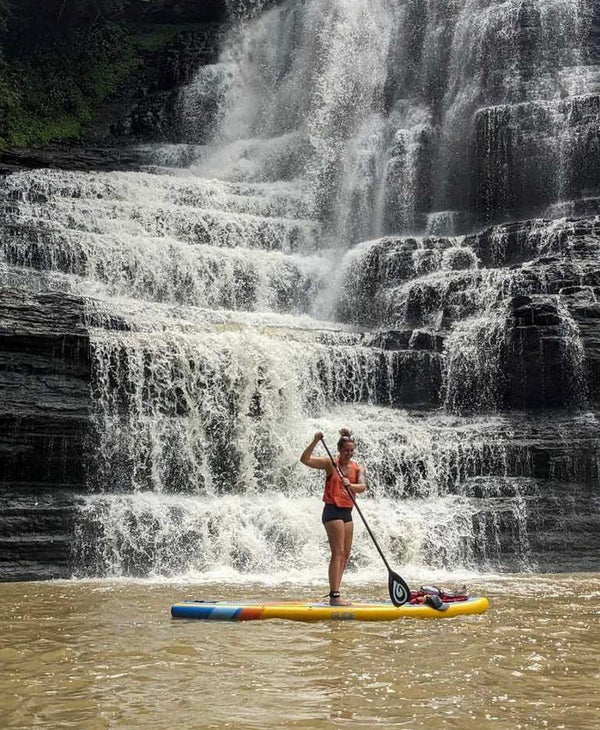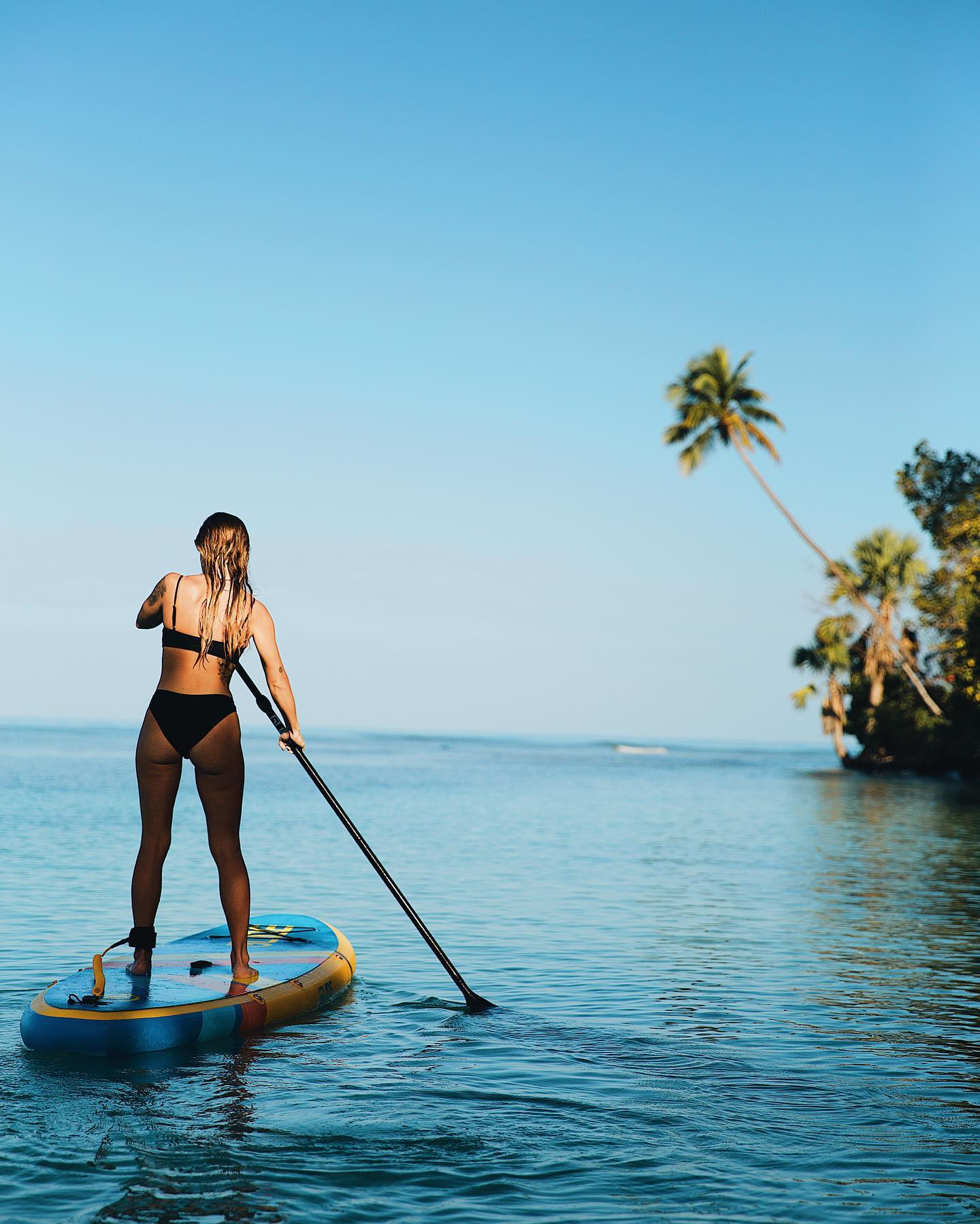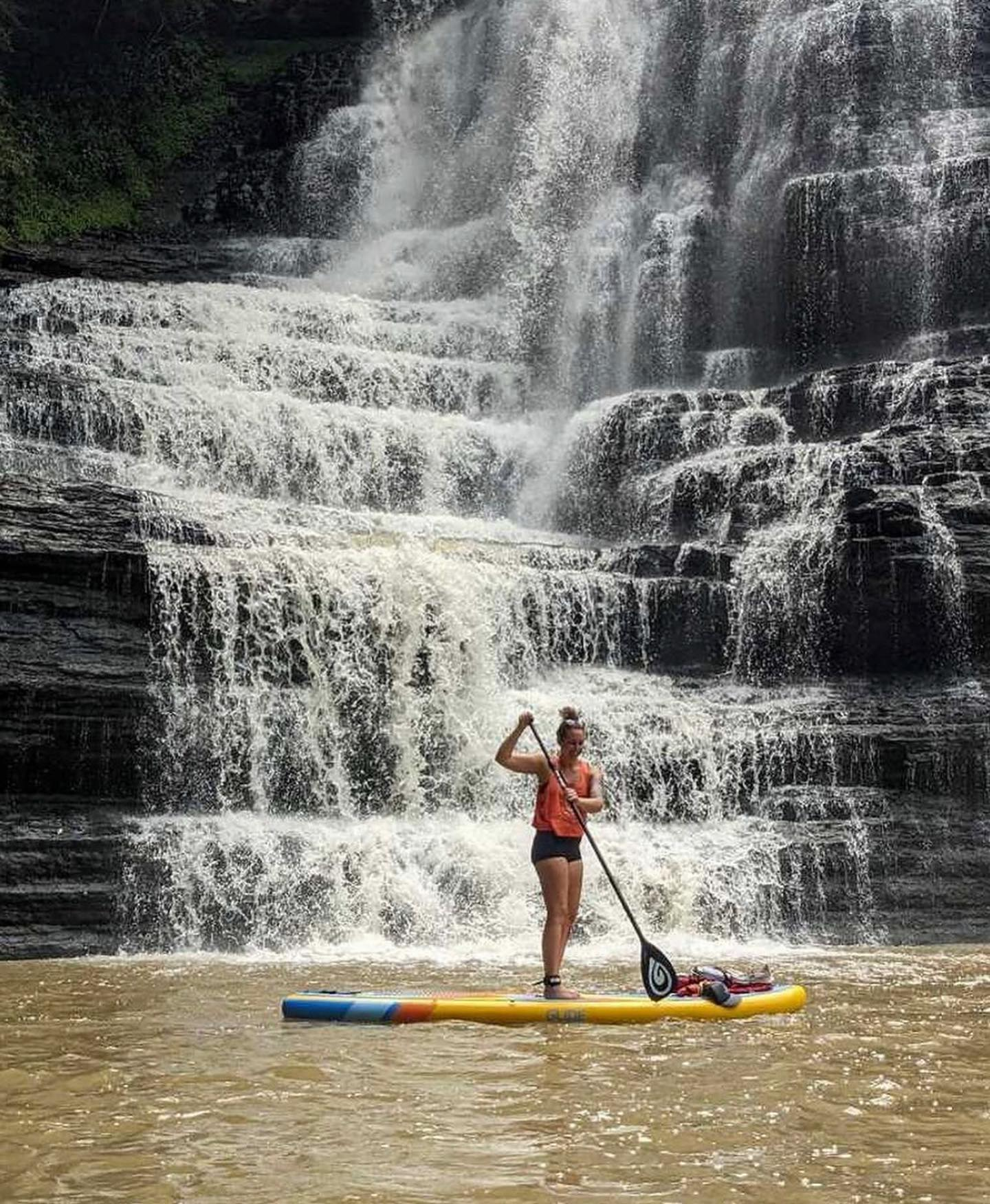
How to Master the Sweep Stroke on your Paddleboard
Turn faster with the sweep stroke. Learn setup, catch, draw, recovery, reverse sweep, step-back pivots, fin tweaks, and drills—plus safety and real-world tactics for waves, wakes, and tight spaces.
The sweep stroke is your primary tool for turning a paddle board quickly and with control—vital for racing buoys, dodging obstacles, navigating marinas, or setting up on waves.
You’ll learn the four phases— setup, catch, draw, recovery—plus how stance and torso rotation create a wide, powerful arc.
The guide adds reverse sweep for tighter corrections and the step-back pivot for rapid spins, then covers board and fin placement that make turning easier. A short drill set helps you groove clean mechanics, while a safety checklist (PFD, leash choice, practice zone) keeps sessions low-risk.
Master this stroke and every turn feels deliberate, not lucky.
Table of contents
Fast, confident turning separates smooth paddlers from frustrated ones. The sweep stroke is your primary turning tool on a paddle board—whether you’re avoiding obstacles, rounding race buoys, lining up for a wave, or navigating marinas. Learn the mechanics (setup → catch → draw → recovery), add the reverse sweep for tighter control, and layer in step-back pivots when you need to spin on a dime. With the right stance, blade angle, and fin placement, you’ll turn on command instead of hoping the board cooperates.

What the Sweep Stroke Does—and When to Use It
The sweep stroke creates a wide, arcing turn by placing the blade at or near the nose and sweeping it out and away from the rail in a crescent toward the tail. The water pushes against the blade and rotates the board around its center. Use it whenever you want a controlled, progressive turn without killing all forward speed: race buoys, crowded docks, surf lineup positioning, or threading boat wake.
-
Forward sweep (outside the turn): Turns the board toward the paddle side (e.g., paddle on right → board turns right).
-
Reverse sweep (by the tail, sweeping forward): Tightens or finishes a turn quickly, turning the board away from the paddle side.
Mechanics: Setup → Catch → Draw → Recovery
Setup
-
Stance: Feet hip-width with knees soft. In chop or tighter turns, use a light offset (front foot a half-foot length ahead).
-
Posture: Tall chest, eyes up, hips stacked over heels; avoid bending at the waist.
-
Grip: Relaxed hands; top hand over the shaft to allow a long arc.
Catch
-
Blade placement: Plant the blade at or just ahead of the nose on the outside of your intended turn.
-
Blade depth: Bury the blade fully—shallow catches slip and splash.
-
Angle: The blade’s power face should push water outward in a broad arc. Stack shoulders so the shaft angle is controlled, not flat.
Draw (the sweep)
-
Arc away from the rail. Sweep the blade outward in a wide crescent from nose toward tail.
-
Rotate from torso and hips. Your core drives the sweep; your arms guide the arc.
-
Maintain pressure, not speed. Think steady pressure on the blade rather than yanking.
-
Board feedback: You should feel the nose carve and the board rotate under your feet without skidding sideways.
Recovery
-
Exit cleanly near the tail. Lift the blade out with minimal splash.
-
Reset early. Return the blade forward to repeat or transition (forward strokes, reverse sweep, or a pivot).
-
Breathe and balance. Keep knees soft; small ankle/hip adjustments keep you stacked.
Add the Reverse Sweep (Tighter Control)
A reverse sweep starts with the blade by the tail, sweeping forward toward the nose on the opposite side you’d use for a forward sweep if you wanted the same turn direction. It’s perfect for tightening the final degrees of a turn, avoiding a piling, or threading tight marinas.
-
Setup: Same stance cues; slightly more offset helps.
-
Catch: Plant by the tail with a fully buried blade.
-
Draw: Sweep forward in a crescent toward the nose, rotating from torso/hips.
-
Linking: Many paddlers do forward sweep + reverse sweep on the opposite side for efficient S-turns.
Step-Back Pivot: Spin on a Dime
When you need maximum rotation, combine a sweep with a light tail pivot.
-
Plant blade on the outside of the intended turn (near the nose).
-
Step back a few inches with your rear foot toward the tail (start small).
-
Unweight the nose slightly and sweep; the tail becomes your pivot point.
-
Recover to neutral stance as soon as the board points where you want.
-
Practice in calm water first; add chop later. Keep your blade planted as a third point of contact while moving feet.
Board & Fin Setup for Easier Turning
-
Board width/length: Shorter and/or narrower boards turn faster but require better balance. All-around shapes turn more easily than long displacement touring hulls.
-
Fin size/placement:
-
Smaller or more upright fin = quicker turns (trade-off: less tracking).
-
Slide fin forward in the box for easier sweep initiation.
-
Slide fin back for tracking and straight-line work (harder to turn).
-
-
Inflation (iSUP): Hit the recommended PSI; under-inflation adds flex and makes turning sloppy.
Common Mistakes & Quick Fixes
-
Shallow catch → Bury the blade fully at the nose; feel a solid anchor before sweeping.
-
Arm-only sweep → Rotate from torso/hips; your core powers the arc.
-
Too-narrow stance → Add a slight offset and keep knees soft for stability.
-
Looking down → Eyes on the horizon; balance improves instantly.
-
Rushing the recovery → Exit clean at the tail and reset the blade forward; sloppy recoveries waste time.
-
Fin too far back → Slide forward for easier turning, especially on touring boards.
Drills to Lock It In (10–15 minutes)
Nose-to-tail arcs: 6 reps each side. Smooth, fully buried catch by the nose; wide arc; clean exit near tail.
Reverse-then-forward: Reverse sweep to start, forward sweep to finish—4 sets per side for tight S-turn control.
Step-back micro-pivots: Plant blade, step rear foot back 2–3 inches, sweep, recover—8 reps alternating sides.
Cone circles: Place two buoys 2–3 board lengths apart. Circle each with three sweeps, then two, then one.
Offset holds: Paddle 3 minutes in a light offset stance, correcting yaw with tiny draws and quick sweeps—great for cross-wind.

Technique Tie-Ins: Stance, Cadence, and the Forward Stroke
-
Stance: Hip-width with light offset in chop; knees act as suspension. If you feel tippy, widen slightly and soften knees.
-
Cadence: In turns, shorter, quicker strokes help you maintain control and avoid yaw swings.
-
Forward stroke integration: After turning, transition to clean catch + early exit forward strokes to regain speed. The faster you settle into clean forward mechanics, the smoother your acceleration out of a turn.
Using the Sweep in Real Conditions
-
Racing: Approach the buoy wide, sweep early, then add a reverse sweep to tighten the exit. For 180° turns, add a step-back pivot and a short power burst.
-
Surf/wakes: Forward sweep to set angle, reverse sweep to fine-tune your line, then step-back to lift the nose if needed.
-
Marinas/docks: Slow it down; use gentle sweeps and reverse sweeps to maneuver without smacking pilings.
-
Wind/chop: Slightly wider/offset stance; plant the blade before moving feet. A smaller fin helps agility but watch tracking on the way home.
Safety Considerations
-
PFD: Wear a USCG-approved PFD.
-
Leash: Use the correct leash for your venue (coiled for flat/open water, quick-release belt for rivers/current, straight leash for surf).
-
Practice zone: Work away from traffic and swimmers; always check wind/current before drills.
-
Comms: Phone/VHF in a waterproof case, and let someone know your route/time.
A Two-Session Sweep Stroke Tune-Up
Session A (flat water):
-
5 min warm-up forward strokes (quiet exits).
-
6× nose-to-tail arcs each side.
-
4× reverse-then-forward sweeps each side.
-
6× step-back micro-pivots (alternate sides).
-
5 min cool-down with clean forward strokes.
Session B (light wind/chop):
-
5 min warm-up, add slight offset stance.
-
6× nose-to-tail arcs with offset stance each side.
-
2× cone circles (three sweeps → two → one).
-
4× step-back micro-pivots with planted blade.
-
5 min cool-down; focus on smooth transitions from sweep to forward stroke.
Stick to these for a week or two and your turns will feel intentional—and faster.

Final Thoughts on the Paddle Board Sweep Stroke
Paddle board sweep stroke mastery turns “I hope I make it” into I know I will. Keep the blade buried, rotate from your torso, and give yourself room to arc. Add reverse sweeps and step-back pivots as you gain confidence, and tweak your fin to match the venue. The more you practice, the more every turn feels deliberate—and the faster you’ll be around buoys, docks, and waves.
FAQs
Which side do I sweep on to turn right?
Sweep on the right side (forward sweep) to turn right; a reverse sweep on the left also turns you right and can tighten the arc.
Where exactly do I plant the blade?
By the nose for a forward sweep; by the tail for a reverse sweep. In both cases, bury the blade fully before moving water.
Do I use arms or core for power?
Your core/torso rotation provides power. Arms guide the arc and blade angle.
How wide should my stance be?
Start hip-width; add a light offset (front foot slightly forward) in chop or for tighter turns.
What fin setup helps turning?
A smaller or more upright fin, placed forward in the box, increases agility (but reduces tracking).
How do I avoid tipping during step-back pivots?
Plant the blade first (third point of contact), step back small increments, keep knees soft, and recover to neutral promptly.
When should I use a reverse sweep?
To tighten or finish a turn quickly, or when space is limited around docks and marinas.
Can inflatables turn well?
Yes—if properly inflated and set up with an appropriate fin. Stiffness and blade control matter more than board type.
Why does my turn feel weak?
Likely a shallow catch or arm-only sweep. Bury the blade and rotate from your torso; slow down to focus on pressure.
Safety basics?
Wear a USCG-approved PFD, use a venue-appropriate leash, practice away from traffic, and check wind/current before drills.





